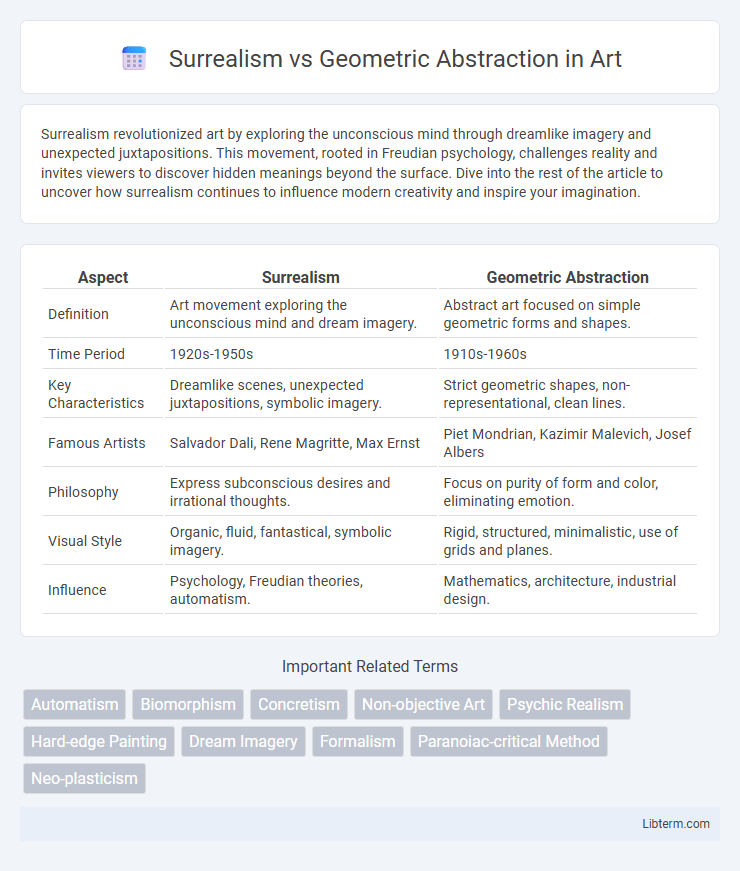Surrealism revolutionized art by exploring the unconscious mind through dreamlike imagery and unexpected juxtapositions. This movement, rooted in Freudian psychology, challenges reality and invites viewers to discover hidden meanings beyond the surface. Dive into the rest of the article to uncover how surrealism continues to influence modern creativity and inspire your imagination.
Table of Comparison
| Aspect | Surrealism | Geometric Abstraction |
|---|---|---|
| Definition | Art movement exploring the unconscious mind and dream imagery. | Abstract art focused on simple geometric forms and shapes. |
| Time Period | 1920s-1950s | 1910s-1960s |
| Key Characteristics | Dreamlike scenes, unexpected juxtapositions, symbolic imagery. | Strict geometric shapes, non-representational, clean lines. |
| Famous Artists | Salvador Dali, Rene Magritte, Max Ernst | Piet Mondrian, Kazimir Malevich, Josef Albers |
| Philosophy | Express subconscious desires and irrational thoughts. | Focus on purity of form and color, eliminating emotion. |
| Visual Style | Organic, fluid, fantastical, symbolic imagery. | Rigid, structured, minimalistic, use of grids and planes. |
| Influence | Psychology, Freudian theories, automatism. | Mathematics, architecture, industrial design. |
Introduction to Surrealism and Geometric Abstraction
Surrealism emerged in the early 1920s as an avant-garde movement emphasizing dreamlike imagery and the unconscious mind, often featuring illogical scenes and bizarre juxtapositions. Geometric abstraction, developing concurrently in the same era, focused on non-representational forms using precise shapes, lines, and color fields to convey meaning without figurative references. Both movements revolutionized modern art by challenging traditional representation, with Surrealism exploring psychological depths and Geometric Abstraction prioritizing formal purity and spatial harmony.
Historical Origins and Development
Surrealism emerged in the early 1920s as a reaction to the horrors of World War I, rooted in the Dada movement and inspired by Freudian psychoanalysis, emphasizing the unconscious and dream imagery in art. Geometric Abstraction developed concurrently during the same period, influenced by Cubism and De Stijl, focusing on non-representational forms with precise shapes and mathematical order. Both movements revolutionized modern art by rejecting traditional representation but diverged in expressing subjective psychology versus objective structure.
Key Philosophies and Ideological Foundations
Surrealism is rooted in exploring the unconscious mind and dreams, emphasizing irrationality, spontaneity, and the liberation of imagination as a rebellion against rational norms. Geometric Abstraction prioritizes order, clarity, and mathematical precision, reflecting a belief in universal truths through structured forms and the reduction of art to basic geometric shapes. Both movements challenge traditional artistic conventions but diverge fundamentally in their philosophical approaches: Surrealism embraces chaos and the subconscious, while Geometric Abstraction seeks harmony through logic and simplification.
Iconic Artists and Their Contributions
Salvador Dali and Rene Magritte, iconic Surrealist artists, revolutionized visual expression by exploring dreamlike imagery and the unconscious mind, influencing modern art with works like Dali's "The Persistence of Memory" and Magritte's "The Son of Man." In contrast, Piet Mondrian and Kazimir Malevich, pivotal figures in Geometric Abstraction, advanced the movement through their rigid use of geometric shapes and primary colors, notably Mondrian's "Composition with Red, Blue, and Yellow" and Malevich's "Black Square," which emphasized pure abstraction and a reduction to essentials. Both movements reshaped 20th-century art, with Surrealism delving into the psyche and Geometric Abstraction focusing on form and structure.
Visual Characteristics and Techniques
Surrealism features dreamlike, illogical imagery with fluid, organic forms often combining unexpected elements to evoke subconscious thoughts, using techniques like automatism and detailed, realistic rendering to enhance the uncanny effect. Geometric Abstraction emphasizes precise shapes such as squares, circles, and triangles, employing hard edges, flat colors, and mathematically structured compositions to convey order and simplicity. Surrealism relies on spontaneous, free-flowing brushwork and symbolic motifs, whereas Geometric Abstraction utilizes carefully planned layouts and uniform application of paint to create non-representational, abstract visuals.
Influences on Contemporary Art
Surrealism's exploration of the unconscious mind and dreamlike imagery has profoundly influenced contemporary art by inspiring artists to incorporate themes of fantasy, irrationality, and psychological depth. Geometric Abstraction's emphasis on precise forms, mathematical structures, and spatial relationships has shaped modern minimalist and conceptual art movements, promoting an aesthetic of clarity and order. Both movements continue to inform contemporary practices by merging emotional expressiveness with structural rigor, fueling innovation across various media and disciplines.
Psychological and Emotional Impact
Surrealism taps into the subconscious mind, evoking dreamlike imagery and emotional depth that challenges rational perceptions and triggers introspective psychological responses. Geometric Abstraction, with its precise lines and shapes, induces a sense of order and clarity, often promoting calm and intellectual engagement rather than emotional turbulence. The contrasting psychological impact lies in Surrealism's stimulation of imagination and unconscious fears, while Geometric Abstraction fosters stability and cognitive reflection through structured visual harmony.
Critical Reception and Art Criticism
Surrealism received critical acclaim for its exploration of the unconscious mind and dreamlike imagery, praised for its innovative approach to psychology and symbolism during the early 20th century. In contrast, Geometric Abstraction was lauded for its emphasis on form, structure, and the use of pure geometric shapes, often regarded by critics as a radical departure from representational art toward universal visual language. Art criticism often highlighted Surrealism's emotional intensity and narrative complexity, whereas Geometric Abstraction was celebrated for its precision, minimalism, and intellectual rigor in modernist art circles.
Lasting Legacy in Modern Art
Surrealism's lasting legacy in modern art is evident through its influence on contemporary visual storytelling, dream-like imagery, and exploration of the unconscious mind, shaping movements such as abstract expressionism and pop art. Geometric Abstraction has enduring significance by emphasizing precision, mathematical structures, and minimalism, paving the way for modern design principles and digital art. Both movements continue to inspire artists worldwide by challenging traditional aesthetics and expanding the boundaries of creative expression.
Comparing Surrealism and Geometric Abstraction
Surrealism emphasizes the unconscious mind, dream imagery, and organic, fluid forms, often portraying fantastical scenes that defy logical interpretation. Geometric Abstraction focuses on precise shapes, mathematical structures, and non-representational compositions, prioritizing order, symmetry, and clarity. While Surrealism explores subconscious narratives and emotional depth, Geometric Abstraction seeks harmony through abstract forms and visual balance.
Surrealism Infographic

 libterm.com
libterm.com